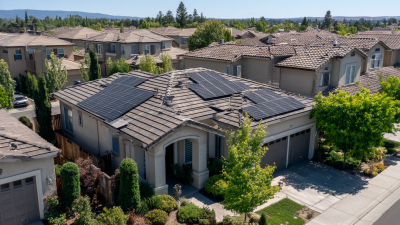MH Energy Your Better Solar and Energy Partner
Leave Your Message
MH Energy Your Better Solar and Energy Partner
As the world increasingly confronts the dual challenges of climate change and energy sustainability, the need to maximize energy efficiency has never been more critical. The integration of solar and battery storage solutions plays a pivotal role in this transition, promising not only to harness renewable energy but also to store it for use when demand peaks.
 With advancements in technology and decreasing costs, solar and battery storage systems have emerged as not only viable alternatives to fossil fuels but also as essential components of a resilient energy infrastructure. This article explores the future of solar and battery storage, examining innovative developments and best practices that can lead to a greener, more efficient energy landscape.
By harnessing the potential of these interlinked technologies, we can create a sustainable energy ecosystem that minimizes waste and maximizes efficiency, ultimately paving the way for a cleaner, more sustainable future.
With advancements in technology and decreasing costs, solar and battery storage systems have emerged as not only viable alternatives to fossil fuels but also as essential components of a resilient energy infrastructure. This article explores the future of solar and battery storage, examining innovative developments and best practices that can lead to a greener, more efficient energy landscape.
By harnessing the potential of these interlinked technologies, we can create a sustainable energy ecosystem that minimizes waste and maximizes efficiency, ultimately paving the way for a cleaner, more sustainable future.
 Solar energy is becoming an increasingly popular choice for homeowners looking to enhance energy efficiency and reduce utility costs. Understanding the fundamentals of solar energy is essential for making informed decisions about installation and utilization. Solar panels convert sunlight into electricity through photovoltaic cells, generating power even on cloudy days, although production is highest in direct sunlight. Homeowners should consider factors such as panel orientation, roof angle, and local climate when determining the suitability of solar energy for their home.
Solar energy is becoming an increasingly popular choice for homeowners looking to enhance energy efficiency and reduce utility costs. Understanding the fundamentals of solar energy is essential for making informed decisions about installation and utilization. Solar panels convert sunlight into electricity through photovoltaic cells, generating power even on cloudy days, although production is highest in direct sunlight. Homeowners should consider factors such as panel orientation, roof angle, and local climate when determining the suitability of solar energy for their home.
In addition to solar panels, incorporating battery storage solutions can significantly increase a household's energy independence. Battery storage systems allow homeowners to store excess energy produced during peak sunlight hours for later use, which can be particularly beneficial during power outages or periods of high electricity demand. Understanding the different types of batteries available, such as lithium-ion and lead-acid, helps homeowners select the right solution for their specific needs. With a thorough grasp of solar energy fundamentals, homeowners can optimize energy efficiency, lower their carbon footprint, and pave the way for a sustainable energy future.
As the global energy landscape continues to evolve, selecting the right solar panels and battery systems becomes crucial for maximizing energy efficiency. With the solar controller market projected to grow from $1.72 billion in 2023 to $2.828 billion by 2031, the increasing demand for efficient energy solutions highlights the necessity of advanced technologies in solar power and battery storage. This growth underscores the transition towards renewable energy sources, where both residential and commercial sectors seek sustainable options to lower energy costs and reduce carbon footprints.
Choosing the right solar panel and battery system involves considering various factors, such as efficiency ratings, durability, and compatibility with existing infrastructures. Emerging technologies are paving the way for innovative solutions that not only enhance energy capture but also improve storage capabilities. As companies pursue acquisitions and partnerships to bolster their capabilities, consumers stand to benefit from a wider selection of efficient, cost-effective solar options that promise long-term energy savings and environmental benefits.
| Solar Panel Type | Efficiency (%) | Cost per Watt ($) | Lifespan (Years) | Battery Storage Type | Capacity (kWh) | Cycle Life | Cost ($) |
|---|---|---|---|---|---|---|---|
| Monocrystalline | 20-22 | 0.70 | 25 | Lithium-ion | 10 | 3000 | 500 |
| Polycrystalline | 15-18 | 0.60 | 25 | Lead Acid | 5 | 500 | 200 |
| Bifacial | 20-25 | 0.80 | 30 | Flow Battery | 20 | 20000 | 1000 |
Optimizing solar panel placement is crucial for maximizing energy efficiency in residential and commercial applications. According to a report from the National Renewable Energy Laboratory (NREL), positioning solar panels at an angle of 30 to 45 degrees can significantly enhance energy capture by optimizing exposure to sunlight throughout the day. Additionally, considering local weather patterns and seasonal sun paths can lead to further improvements in energy generation.
When it comes to energy storage solutions, incorporating battery systems can effectively ensure that excess energy generated during peak sunlight hours is stored for later use. Research by BloombergNEF indicates that the cost of lithium-ion batteries has dropped by 89% since 2010, making them more accessible for homeowners and businesses looking to increase their energy independence. This revolution in battery technology allows for a smoother transition to sustainable energy solutions, particularly in areas prone to power outages or those with high energy costs.
Tips:
1. Before installation, conduct a shading analysis to identify potential obstructions that might limit sunlight exposure to your solar panels.
2. Consider pairing solar panels with a smart battery management system to optimize charging cycles and ensure maximum efficiency.
3. Regular maintenance and cleaning of solar panels can enhance energy output by as much as 20%, according to the Solar Energy Industries Association (SEIA).
The future of energy efficiency heavily relies on smart energy management systems that integrate solar and battery storage solutions. As the global IoT energy management market is projected to grow from $70.58 billion in 2023 to $222.56 billion by 2030, with a compound annual growth rate of 17.8%, the demand for innovative solutions becomes imperative. These systems not only optimize energy consumption but also facilitate the transition to a carbon-neutral energy ecosystem.
Tips: Implementing a smart energy management system involves utilizing advanced software that enables real-time monitoring and analytics. By leveraging machine learning algorithms, these systems can predict energy usage patterns and suggest modifications to enhance efficiency.
Moreover, the shift towards software-defined energy management is transforming residential solar and storage markets. By focusing on intelligent, data-driven solutions, homeowners can achieve greater control over their energy consumption, reducing costs and improving sustainability. Establishing an integrated approach that encompasses renewable energy sources, energy storage, and smart management systems is crucial for maximizing efficiency and promoting a greener future.
Tips: Always choose systems that offer compatibility with various energy devices to ensure flexibility and adaptability as technology evolves.

As the global focus on sustainable energy sources intensifies, incentives and rebates for solar and battery investments play a crucial role in encouraging homeowners and businesses to adopt these technologies. Governments and local authorities offer various financial incentives, such as tax credits, grants, and subsidies, to help offset the initial costs associated with installing solar panels and battery storage systems. These programs not only promote green energy but also spur economic growth by creating jobs in the renewable energy sector.
Additionally, utility companies often provide rebates for customers who invest in energy-efficient systems. By participating in net metering programs, solar users can sell excess energy back to the grid, further enhancing the financial benefits of their investments. The combination of government incentives and utility rebates significantly reduces the payback period for solar and battery systems, making them more accessible to a wider audience. This collaborative approach is essential for driving the transition towards a resilient and sustainable energy future.






